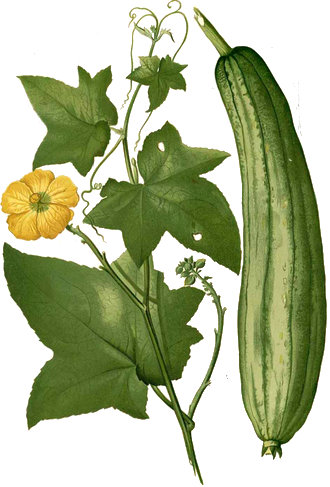 |
| Luffa operculata |
It is known botanically as Luffa purgans Mart, Luffa operculata Linn. Cogn., Momordica operculata Linn or Poppia operculata M. Roem. This species is commercially not available in India. It is found in Southern part of North America or Northern part of South America and especially in Columbia. A homoeopathic tincture is made from the fruits with about 65% of alcohol1. It is an official drug of Homoeopathic Pharmacopoeia of India2 and Homoeopathic Pharmacopoeia of United States3.
In common language it is called by the locals “Espongilla”. It was introduced in Europe by Dr. Willmar Schwabe who also carried the proving of the medicine. It was read as scientific paper at International Homoeopathic Congress in 1962 by Dr. Schwabe and Dr. Stubes. Clinical results on over 600 cases were compiled by Ingo Kulinke. It is a constituent of well-known Luffa complexes and longenzes for allergic respiratory and throat problems used worldwide for decades4.
Briefly the indication for the drug is lassitude, physical fatigue, broken condition with indifference, hypertrophy of the thyroid gland, sensation of burning at the tip of the tongue; painful sensation of thirst and hunger, difficult to calm down, diffused gastric pains, sensation of emptiness in the stomach; canine hunger with emaciation; tendency to constipation. Breathlessness by the least effort and is useful for tachycardia. The other symptoms for the medicine are violent headaches starting from the forehead going towards the neck, pain in the occipital region, frontal pains with vertigo and feeling of flies flying before the eyes; cold with nasal secretion, clear or yellow, specially in the morning. Dryness of the nasal mucous with adhering crust formations. All symptoms have tendency to aggravate in confined air or dry air in the room and better by fresh air of the outside. Less important symptoms are formation of small pimples, which may be purulent and itching on the face, on the lower lip, and on the chin, abundant loss of hairs.4,5
It is best used for front-occipital headaches, acute or chronic inflammation of the mucosa of the nasal fossa, hypertrophy or atrophy of the nasal mucous as found in rhino-pharyngo-laryngitis, purulent sinusitis, chronic atrophic rhinitis, bronchial asthma and nasal polyps. 4,5,6
Recommended dose: 5-10 drops of Ø, 2-3 times a day
References:
1. P. N. Varma, Indu Vaid, Encyclopaedia of Homoeopathic Pharmacopoeia, Updated edition 2007, B. Jain Publishers, New Delhi.
2. Homoeopathic Pharmacopoeia of India, Department of Ayurveda, Yoga & Naturopathy, Unani, Siddha and Homoeopathy, Ministry of Health and Family Welfare, Government of India.
3. Homoeopathic Pharmacopoeia of the United States, Southeastern, PA, Homoeopathic Pharmacopeia Convention of the United States (available by subscription at http://www.hpus.com).
4. O. A. Julian, Materia Medica of New Homoeopathic Remedies, RadarOpus 1.33, Archibel S.A. Rue Fontaine St. Pierre 1E, Zoning Industriel de la Fagne, 5330 Assesse, Belgium.
5. R. Murphy, Homoeopathic Remedy Guide, RadarOpus 1.33, Archibel S.A. Rue Fontaine St. Pierre 1E, Zoning Industriel de la Fagne, 5330 Assesse, Belgium.
6. Sean C Sweetman, Martindale, Pharmaceutical Press, London, Thirty Third Edition, 2002. Formerly known as Extra Pharmacopoeia by Martindale.
Source SCHWABE NEWS